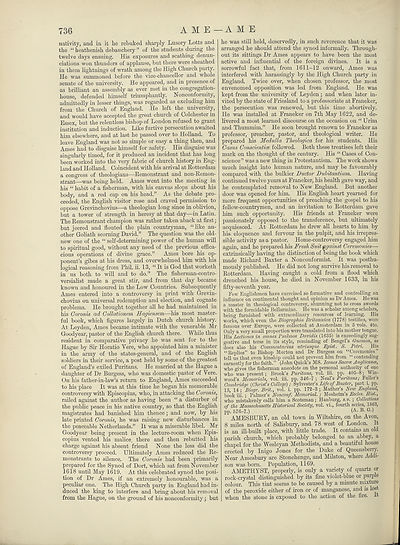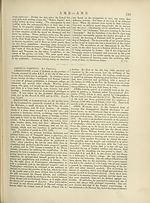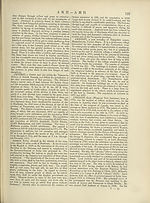Encyclopaedia Britannica > Volume 1, A-Anatomy
(750) Page 736
Download files
Complete book:
Individual page:
Thumbnail gallery: Grid view | List view

736 A M E -
nativity, and in it lie rebuked sharply Lusory Lotts and
the “ heathenish debauchery ” of the students during the
twelve days ensuing. His exposures and scathing denun¬
ciations won thunders of applause, but there were sheathed
in them lightnings of wrath among the High Church party.
He was summoned before the vice-chancellor and whole
senate of the university. He appeared, and in presence of
as brilliant an assembly as ever met in the congregation-
house, defended himself triumphantly. Nonconformity,
admittedly in lesser things, was regarded as excluding him
from the Church of England. He left the university,
and would have accepted the great church of Colchester in
Essex, but the relentless bishop of London refused to grant
institution and induction. Like furtive persecution awaited
him elsewhere, and at last he passed over to Holland. To
leave England was not so simple or easy a thing then, and
Ames had to disguise himself for safety. His disguise was
singularly timed, for it produced an incident that has long
been worked into the very fabric of church history in Eng¬
land and Holland. Coincident with his arrival at Rotterdam
a congress of theologians—Remonstrant and non-Remon-
strant—was being held. Ames went into the meeting in
his “ habit of a fisherman, with his canvas slops about his
body, and a red cap on his head.” As the debate pro¬
ceeded, the English visitor rose and craved permission to
oppose Grevinchovius—a theologian long since in oblivion,
but a tower of strength in heresy at that day—in Latin.
The Remonstrant champion was rather taken aback at first;
but jeered and flouted the plain countryman, “ like an¬
other Goliath scorning David.” The question was the old-
new one of the “ self-determining power of the human will
to spiritual good, without any need of the previous effica¬
cious operations of divine grace.” Ames bore his op¬
ponent’s gibes at his dress, and overwhelmed him with his
logical reasoning from Phil. ii. 13, “ It is God that worketh
in us both to will and to do.” The fisherman-contro¬
versialist made a great stir, and from that day became
known and honoured in the Low Countries. Subsequently
Ames entered into a controversy in print with Grevin¬
chovius on universal redemption and election, and cognate
problems. He brought together all he had maintained in
his Coronis ad Collationem Hagiensem—his most master¬
ful book, which figures largely in Dutch church history.
At Leyden, Ames became intimate with the venerable Mr
Goodyear, pastor of the English church there. While thus
resident in comparative privacy he was sent for to the
Hague by Sir Horatio Yere, who appointed him a minister
in the army of the states-general, and of the English
soldiers in their service, a post held by some of the greatest
of England’s exiled Puritans. He married at the Hague a
daughter of Dr Burgess, who was domestic pastor of Yere.
On his father-in-law’s return to England, Ames succeeded
to his place It was at this time he began his memorable
controversy with Episcopius, who, in attacking the Coronis,
railed against the author as having been “ a disturber of
the public peace in his native country, so that the English
magistrates had banished him thence; and now, by his
late printed Coronis, he was raising new disturbances in
the peaceable Netherlands.” It was a miserable libel. Mr
Goodyear being present in the lecture-room when Epis¬
copius vented his malice/ there and then rebutted his
charge against his absent friend None the less did the
controversy proceed. Ultimately Ames reduced the Re¬
monstrants to silence. The Coronis had been primarily
prepared for the Synod of Dort, which sat from November
1618 until May 1619. At this celebrated synod the posi¬
tion of Dr Ames, if an extremely honourable, was a
peculiar one. The High Church party in England had in¬
duced the king to interfere and bring about his removal
from the Hague, on the ground of his nonconformity; but
- A M E
he was still held, deservedly, in such reverence that it was
arranged he should attend the synod informally. Through¬
out its sittings Dr Ames appears to have been the most
active and influential of the foreign divines. It is a
sorrowful fact that, from 1611-12 onward, Ames was
interfered with harassingly by the High Church party in
England. Twice over, when chosen professor, the most
envenomed opposition was led from England. He was
kept from the university of Leyden; and when later in¬
vited by the state of Friesland to a professoriate at Franeker,
the persecution was renewed, but this time abortively.
He was installed at Franeker on 7th May 1622, and de¬
livered a most learned discourse on the occasion on “ Urim
and Thummim.” He soon brought renown to Franeker as
professor, preacher, pastor, and theological writer. He
prepared his Medulla Theologica for his students. His
Casus Conscientioe followed. Both these treatises left their
mark on the thought of the century. His “ Cases of Con¬
science” was a new thing in Protestantism. The work shows
much insight into human nature, and may be favourably
compared with the bulkier Ductor Dukitantium. Having
continued twelve years at Franeker, his health gave way, and
he contemplated removal to New England. But another
door was opened for him. His English heart yearned for
more frequent opportunities of preaching the gospel to his
fellow-countrymen, and an invitation to Rotterdam gave
him such opportunity. His friends at Franeker were
passionately opposed to the transference, but ultimately
acquiesced. At Rotterdam he drew all hearts to him by
his eloquence and fervour in the pulpit, and his irrepres¬
sible activity as a pastor. Home-controversy engaged him
again, and he prepared his Fresh Suit against Ceremonies—
extrinsically having the distinction of being the book which
made Richard Baxter a Nonconformist. It was posthu¬
mously published. He did not long survive his removal to
Rotterdam. Having caught a cold from a flood which
drenched his house, he died in November 1633, in his
fifty-seventh year.
Few Englishmen have exercised so formative and controlling an
iniluence on continental thought and opinion as Dr Ames. He was
a master in theological controversy, shunning not to cross swords
with the formidable Bellarmine. He was a scholar among scholars,
being furnished with extraordinary resources of learning. His
works, which even the Biographia Britannica (1778) testifies, were
famous over Europe, were collected at Amsterdam in 5 vols. 4to.
Only a very small proportion were translated into his mother tongue.
His Lectiones in omnes Bsalmos Davidis (1635) is exceedingly sug¬
gestive and terse in its style, reminding of Bengel’s Gnomon, as
does also his Commentarius utriusque Epist. 8. Petri. His
“Replies” to Bishop Morton and Dr Burgess on “Ceremonies”
tell us that even kinship could not prevent him from “ contending
earnestly for the faith. ” (John Quick’s MS. leones Sacra Anglicance,
who gives the fisherman anecdote on the personal authority of one
who was present; Brook’s Puritans, vol. iii. pp. 405-8 ; W in¬
wood’s Memorials, vol. iii. pp. 346-7 ; Neal’s Puritans; Fuller’s
Cambridge {Christ's College); Sylvester’s Life of Baxter, part i. pp.
13, 14 ; Biogr. Brit., vol. i. pp. 172-3 ; Mather’s New England,
book iii. ; Palmer’s Nonconf. Memorial. ; Mosheim’s EceUs. Hist.,
who mistakenly calls him a Scotsman; Hanburg, s.v. ; Collections
of the Massachusetts Historical Society, vol. vi., fourth series, 1863,
pp. 576-7.) (A- B- G‘)
AMESBURY, an old town in Wiltshire, on the Avon,
8 miles north of Salisbury, and 78 west of London. It
is an ill-built place, with little trade. It contains an old
parish church, which probably belonged to an abbey, a
chapel for the Wbsleyan Methodists, and a beautiful house
erected by Inigo Jones for the Duke of Queensbeiry.
Near Amesbury are Stonehenge, and Milston, where Addi¬
son was born. Population, 1169.
AMETHYST, properly, is only a variety of quartz or
rock-crystal distinguished by its fine violet-blue or purple
colour. This tint seems to be caused by a minute mixture
of the peroxide either of iron or of manganese, and is lost
when the stone is exposed to the action of the fire. It
nativity, and in it lie rebuked sharply Lusory Lotts and
the “ heathenish debauchery ” of the students during the
twelve days ensuing. His exposures and scathing denun¬
ciations won thunders of applause, but there were sheathed
in them lightnings of wrath among the High Church party.
He was summoned before the vice-chancellor and whole
senate of the university. He appeared, and in presence of
as brilliant an assembly as ever met in the congregation-
house, defended himself triumphantly. Nonconformity,
admittedly in lesser things, was regarded as excluding him
from the Church of England. He left the university,
and would have accepted the great church of Colchester in
Essex, but the relentless bishop of London refused to grant
institution and induction. Like furtive persecution awaited
him elsewhere, and at last he passed over to Holland. To
leave England was not so simple or easy a thing then, and
Ames had to disguise himself for safety. His disguise was
singularly timed, for it produced an incident that has long
been worked into the very fabric of church history in Eng¬
land and Holland. Coincident with his arrival at Rotterdam
a congress of theologians—Remonstrant and non-Remon-
strant—was being held. Ames went into the meeting in
his “ habit of a fisherman, with his canvas slops about his
body, and a red cap on his head.” As the debate pro¬
ceeded, the English visitor rose and craved permission to
oppose Grevinchovius—a theologian long since in oblivion,
but a tower of strength in heresy at that day—in Latin.
The Remonstrant champion was rather taken aback at first;
but jeered and flouted the plain countryman, “ like an¬
other Goliath scorning David.” The question was the old-
new one of the “ self-determining power of the human will
to spiritual good, without any need of the previous effica¬
cious operations of divine grace.” Ames bore his op¬
ponent’s gibes at his dress, and overwhelmed him with his
logical reasoning from Phil. ii. 13, “ It is God that worketh
in us both to will and to do.” The fisherman-contro¬
versialist made a great stir, and from that day became
known and honoured in the Low Countries. Subsequently
Ames entered into a controversy in print with Grevin¬
chovius on universal redemption and election, and cognate
problems. He brought together all he had maintained in
his Coronis ad Collationem Hagiensem—his most master¬
ful book, which figures largely in Dutch church history.
At Leyden, Ames became intimate with the venerable Mr
Goodyear, pastor of the English church there. While thus
resident in comparative privacy he was sent for to the
Hague by Sir Horatio Yere, who appointed him a minister
in the army of the states-general, and of the English
soldiers in their service, a post held by some of the greatest
of England’s exiled Puritans. He married at the Hague a
daughter of Dr Burgess, who was domestic pastor of Yere.
On his father-in-law’s return to England, Ames succeeded
to his place It was at this time he began his memorable
controversy with Episcopius, who, in attacking the Coronis,
railed against the author as having been “ a disturber of
the public peace in his native country, so that the English
magistrates had banished him thence; and now, by his
late printed Coronis, he was raising new disturbances in
the peaceable Netherlands.” It was a miserable libel. Mr
Goodyear being present in the lecture-room when Epis¬
copius vented his malice/ there and then rebutted his
charge against his absent friend None the less did the
controversy proceed. Ultimately Ames reduced the Re¬
monstrants to silence. The Coronis had been primarily
prepared for the Synod of Dort, which sat from November
1618 until May 1619. At this celebrated synod the posi¬
tion of Dr Ames, if an extremely honourable, was a
peculiar one. The High Church party in England had in¬
duced the king to interfere and bring about his removal
from the Hague, on the ground of his nonconformity; but
- A M E
he was still held, deservedly, in such reverence that it was
arranged he should attend the synod informally. Through¬
out its sittings Dr Ames appears to have been the most
active and influential of the foreign divines. It is a
sorrowful fact that, from 1611-12 onward, Ames was
interfered with harassingly by the High Church party in
England. Twice over, when chosen professor, the most
envenomed opposition was led from England. He was
kept from the university of Leyden; and when later in¬
vited by the state of Friesland to a professoriate at Franeker,
the persecution was renewed, but this time abortively.
He was installed at Franeker on 7th May 1622, and de¬
livered a most learned discourse on the occasion on “ Urim
and Thummim.” He soon brought renown to Franeker as
professor, preacher, pastor, and theological writer. He
prepared his Medulla Theologica for his students. His
Casus Conscientioe followed. Both these treatises left their
mark on the thought of the century. His “ Cases of Con¬
science” was a new thing in Protestantism. The work shows
much insight into human nature, and may be favourably
compared with the bulkier Ductor Dukitantium. Having
continued twelve years at Franeker, his health gave way, and
he contemplated removal to New England. But another
door was opened for him. His English heart yearned for
more frequent opportunities of preaching the gospel to his
fellow-countrymen, and an invitation to Rotterdam gave
him such opportunity. His friends at Franeker were
passionately opposed to the transference, but ultimately
acquiesced. At Rotterdam he drew all hearts to him by
his eloquence and fervour in the pulpit, and his irrepres¬
sible activity as a pastor. Home-controversy engaged him
again, and he prepared his Fresh Suit against Ceremonies—
extrinsically having the distinction of being the book which
made Richard Baxter a Nonconformist. It was posthu¬
mously published. He did not long survive his removal to
Rotterdam. Having caught a cold from a flood which
drenched his house, he died in November 1633, in his
fifty-seventh year.
Few Englishmen have exercised so formative and controlling an
iniluence on continental thought and opinion as Dr Ames. He was
a master in theological controversy, shunning not to cross swords
with the formidable Bellarmine. He was a scholar among scholars,
being furnished with extraordinary resources of learning. His
works, which even the Biographia Britannica (1778) testifies, were
famous over Europe, were collected at Amsterdam in 5 vols. 4to.
Only a very small proportion were translated into his mother tongue.
His Lectiones in omnes Bsalmos Davidis (1635) is exceedingly sug¬
gestive and terse in its style, reminding of Bengel’s Gnomon, as
does also his Commentarius utriusque Epist. 8. Petri. His
“Replies” to Bishop Morton and Dr Burgess on “Ceremonies”
tell us that even kinship could not prevent him from “ contending
earnestly for the faith. ” (John Quick’s MS. leones Sacra Anglicance,
who gives the fisherman anecdote on the personal authority of one
who was present; Brook’s Puritans, vol. iii. pp. 405-8 ; W in¬
wood’s Memorials, vol. iii. pp. 346-7 ; Neal’s Puritans; Fuller’s
Cambridge {Christ's College); Sylvester’s Life of Baxter, part i. pp.
13, 14 ; Biogr. Brit., vol. i. pp. 172-3 ; Mather’s New England,
book iii. ; Palmer’s Nonconf. Memorial. ; Mosheim’s EceUs. Hist.,
who mistakenly calls him a Scotsman; Hanburg, s.v. ; Collections
of the Massachusetts Historical Society, vol. vi., fourth series, 1863,
pp. 576-7.) (A- B- G‘)
AMESBURY, an old town in Wiltshire, on the Avon,
8 miles north of Salisbury, and 78 west of London. It
is an ill-built place, with little trade. It contains an old
parish church, which probably belonged to an abbey, a
chapel for the Wbsleyan Methodists, and a beautiful house
erected by Inigo Jones for the Duke of Queensbeiry.
Near Amesbury are Stonehenge, and Milston, where Addi¬
son was born. Population, 1169.
AMETHYST, properly, is only a variety of quartz or
rock-crystal distinguished by its fine violet-blue or purple
colour. This tint seems to be caused by a minute mixture
of the peroxide either of iron or of manganese, and is lost
when the stone is exposed to the action of the fire. It
Set display mode to:
![]() Universal Viewer |
Universal Viewer | ![]() Mirador |
Large image | Transcription
Mirador |
Large image | Transcription
Images and transcriptions on this page, including medium image downloads, may be used under the Creative Commons Attribution 4.0 International Licence unless otherwise stated. ![]()
| Encyclopaedia Britannica > Encyclopaedia Britannica > Volume 1, A-Anatomy > (750) Page 736 |
|---|
| Permanent URL | https://digital.nls.uk/194330599 |
|---|
| Shelfmark | EB.17 |
|---|---|
| Attribution and copyright: |
|
| Shelfmark | EB.17 |
|---|---|
| Description | Ten editions of 'Encyclopaedia Britannica', issued from 1768-1903, in 231 volumes. Originally issued in 100 weekly parts (3 volumes) between 1768 and 1771 by publishers: Colin Macfarquhar and Andrew Bell (Edinburgh); editor: William Smellie: engraver: Andrew Bell. Expanded editions in the 19th century featured more volumes and contributions from leading experts in their fields. Managed and published in Edinburgh up to the 9th edition (25 volumes, from 1875-1889); the 10th edition (1902-1903) re-issued the 9th edition, with 11 supplementary volumes. |
|---|---|
| Additional NLS resources: |
|

